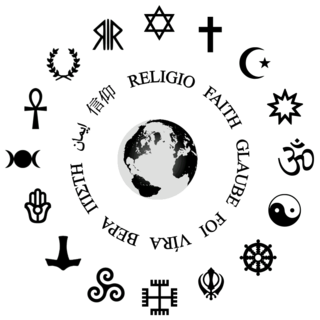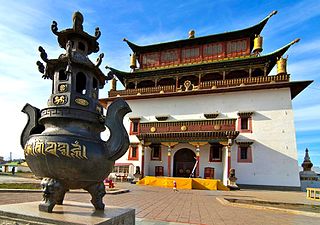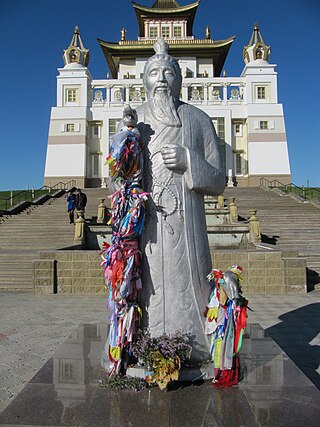
The history of religion refers to the written record of human religious feelings, thoughts, and ideas. This period of religious history begins with the invention of writing about 5,200 years ago. The prehistory of religion involves the study of religious beliefs that existed prior to the advent of written records. One can also study comparative religious chronology through a timeline of religion, or the interrelationships and historical diversification of religious ideologies through the use of evolutionary philosophy and broad comparativism. Writing played a major role in standardizing religious texts regardless of time or location and making easier the memorization of prayers and divine rules.
Religious conversion is the adoption of a set of beliefs identified with one particular religious denomination to the exclusion of others. Thus "religious conversion" would describe the abandoning of adherence to one denomination and affiliating with another. This might be from one to another denomination within the same religion, for example, from Protestant Christianity to Roman Catholicism or from Shi'a Islam to Sunni Islam. In some cases, religious conversion "marks a transformation of religious identity and is symbolized by special rituals".

The following outline is provided as an overview of and topical guide to religion:

A temple is a place of worship, a building used for spiritual rituals and activities such as prayer and sacrifice. By convention, the specially built places of worship of some religions are commonly called "temple" in English, while those of other religions are not, even though they fulfill very similar functions. The religions for which the terms are used include the great majority of ancient religions that are now extinct, such as the Ancient Egyptian religion and the Ancient Greek religion. Among religions still active: Hinduism, Buddhism, Sikhism, Jainism, Zoroastrianism, the Baháʼí Faith, Taoism, Shinto, Confucianism.

Religious music is a type of music that is performed or composed for religious use or through religious influence. It may overlap with ritual music, which is music, sacred or not, performed or composed for or as a ritual. Religious songs have been described as a source of strength, as well as a means of easing pain, improving one's mood, and assisting in the discovery of meaning in one's suffering. While style and genre vary broadly across traditions, religious groups still share a variety of musical practices and techniques.
This is an index page of Wikipedia articles related to the topic of religion.

A libation is a ritual pouring of a liquid as an offering to a deity or spirit, or in memory of the dead. It was common in many religions of antiquity and continues to be offered in cultures today.

A sacred language, holy language or liturgical language is a language that is cultivated and used primarily for religious reasons by people who speak another, primary language in their daily lives.

The predominant religion in Brazil is Christianity, with Catholicism being its largest denomination.
Religion in Singapore is characterised by a wide variety of religious beliefs and practices due to its diverse ethnic mix of people originating from various parts of the world. A secular state, Singapore is commonly termed as a "melting pot" or "cultural mosaic " of various religious practices originating from different religions and religious denominations around the world. Most major religious denominations are present in the country, with the Singapore-based Inter-Religious Organisation recognising 10 major religions. A 2014 analysis by the Pew Research Center found Singapore to be the world's most religiously diverse nation.
Religion in Hong Kong is characterised by a multi-faith diversity of beliefs and practices.

Throughout the ages, there have been various popular religious traditions practiced on the Korean peninsula. The oldest indigenous religion of Korea is the Korean folk religion, Korean shamanism, which has been passed down from prehistory to the present. Buddhism was introduced to Korea from China during the Three Kingdoms era in the fourth century, and the religion became an important part of the culture until the Joseon Dynasty when Confucianism was established as the state philosophy. During the Late Joseon Dynasty, in the 19th century, Christianity began to take root in Korea. While both Christianity and Buddhism would play important roles in the resistance to the Japanese occupation of Korea in the first half of the 20th century, only about 4% of Koreans were members of a religious organization in 1940.

The Obando Fertility Rites are a dance ritual, Anitist in origin, that later became a Catholic festival celebrated every May in Obando, Bulacan, Philippines. Locals and pilgrims, sometimes dressed in traditional costume, dance and sing in the town's streets to honour and beseech Obando's three patron saints: San Pascual, Santa Clara and Nuestra Señora de Salambáo.
There are no known official statistics of religions in North Korea. Officially, North Korea is an atheist state, although its constitution guarantees free exercise of religion, provided that religious practice does not introduce foreign forces, harm the state, or harm the existing social order. Based on estimates from the late 1990s and the 2000s, North Korea is mostly irreligious, with the main religions being Shamanism and Chondoism. There are small communities of Buddhists and Christians. Chondoism is represented in politics by the Party of the Young Friends of the Heavenly Way, and is regarded by the government as Korea's "national religion" because of its identity as a minjung (popular) and "revolutionary anti-imperialist" movement.

Religion in Mongolia has been traditionally dominated by the schools of Mongolian Buddhism and by Mongolian shamanism, the ethnic religion of the Mongols. Historically, through their Mongol Empire the Mongols were exposed to the influences of Christianity and Islam, although these religions never came to dominate. During the communist period of the Mongolian People's Republic (1924–1992) all religions were suppressed, but with the transition to the parliamentary republic in the 1990s there has been a general revival of faiths.

Theravada Buddhism is the largest and dominant religion in Laos. Theravada Buddhism is central to Lao cultural identity. The national symbol of Laos is the That Luang stupa, a stupa with a pyramidal base capped by the representation of a closed lotus blossom which was built to protect relics of the Buddha. It is practiced by 66% of the population. Almost all ethnic or "lowland" Lao people are followers of Theravada Buddhism; however, they constitute more than 50% of the population. The remainder of the population belongs to at least 48 distinct ethnic minority groups. Most of these ethnic groups are practitioners of Tai folk religions, with beliefs that vary greatly among groups.
The majority of South Koreans have no religion. Buddhism and Christianity are the dominant confessions among those who affiliate with a formal religion.

Tsagaan Ubgen is the Mongolian guardian of life and longevity, one of the symbols of fertility and prosperity in the Buddhist pantheon. He is worshiped as a deity in what scholars have called "white shamanism", a subdivision of what scholars have called "Buryat yellow shamanism"—that is, a tradition of shamanism that "incorporate[s] Buddhist rituals and beliefs" and is influenced specifically by Tibetan Buddhism. Sagaan Ubgen originated in Mongolia.
Mun or Munism is the traditional polytheistic, animist, shamanistic and syncretic religion of the Lepcha people. It predates the 7th century Lepcha conversion to Lamaistic Buddhism, and since that time, the Lepcha have practiced it together with Buddhism. Since the arrival of Christian missionaries in the nineteenth century, Mun traditions have been followed alongside that religion as well. The traditional religion permits incorporation of Buddha and Jesus Christ as deities, depending on household beliefs.











